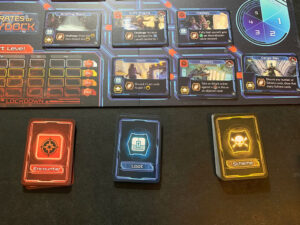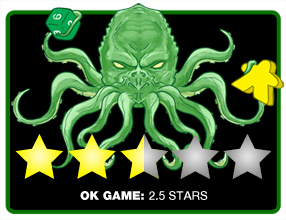 When I got a copy of Starfinder: Pirates of Skydock, I thought the theme looked pretty neat. Sci-fi pirates? Pretty cool, right? It did not occur to me that Starfinder was Pathfinder in space, which is perhaps a connection that I should have made at that point, and not when I went to write the review on it. Which is all to say, I had no preconceived notions going into this, as I did not realize there was a pre-existing IP involved. I just thought it looked cool (and it does).
When I got a copy of Starfinder: Pirates of Skydock, I thought the theme looked pretty neat. Sci-fi pirates? Pretty cool, right? It did not occur to me that Starfinder was Pathfinder in space, which is perhaps a connection that I should have made at that point, and not when I went to write the review on it. Which is all to say, I had no preconceived notions going into this, as I did not realize there was a pre-existing IP involved. I just thought it looked cool (and it does).
Starfinder: Pirates of Skydock is a game for 2-4 players. It is a fast-paced game. The best experience is with 3-4 players.
Gameplay Overview:

Thematically, the players are tenuously working together to hijack a ship before it launches without causing too much trouble with the ship’s security. Your working relationship with your fellow players is somewhat rocky though, as you’re also attempting to out-do each other, and secretly have different financial backers looking to buy the ship from you once (and if) you are successful in your heist.
There’s a lot going on here, and a lot of components, but ultimately the gameplay itself is fairly simple and quick. It is all broken up into three phases, two of which are pretty simple—the Planning Phase and the Upkeep Phase. As the name suggests they are just preparation and maintenance. The third, middle phase, is the Action Phase, which will take up the bulk of the gameplay. The players take turns carrying out their selected actions (one of the choices made during the Planning Phase), either drawing cards, completing objectives and challenges, or moving around the ship. Once all players have used their allotted actions, the phase ends, and you conduct the brief upkeep phase.
And that’s it. The gameplay moves fairly quickly, and there are only five rounds. At the end of five rounds, the ship launches and the game ends, whether the hijacking was successful or not.

Game Experience:
The main part of the game is the Action Phase, though it is highly contingent on the Planning Phase. Each player has a character which has a unique ability and a unique starting array of action tokens. These characters and the indicated action tokens are slotted into the player board, which is pretty neat in concept. Throughout the game, you can add to or upgrade these starting action tokens, and each unique character has a subtly different set. During the Planning Phase, you place cubes on four different actions on your player board in order to set up your intended actions for the round.

Each of the actions are simple, and they all scale up in different ways to allow you to improve them with upgrades. Loot and Scheme actions allow you to get more cards in hand; Move actions get you around the ship; Attack actions help you deal with the ship’s guards; and Interact actions are key to completing your objectives. The Heal action fixes you or others up after being attacked by guards, but it was the least common selection.
There are a lot of moving parts to this. To complete the objectives, you need Scheme cards. Scheme cards, however, also have useful effects, using them for that prevents you from using them to complete objectives. Loot cards generally do not directly contribute to objectives, but they are your primary means for upgrading your abilities, and can also have abilities of their own that are helpful, similar to Schemes. Upgrading your abilities is necessary to be able to get everything done.

Moving around the ship is important, as each room has different ways you can use the Interact action, and some objectives will require you to be in certain rooms. Doing so too much though runs a greater risk of running into more guards via random encounters, who can hamper your ability to use all your actions and raise the alert level of the ship. Should the alert level max out, the ship locks down and everyone loses.
All of those moving parts and things to consider are in pursuit of the ultimate objective: completing the three objectives. Each player only needs to complete one of them in order to be eligible to win, but the more you complete, the more endgame scoring points you have (called Glory in this game). There are other ways to get Glory, such as defeating guards or healing damage, but completing the primary objectives is the biggest single source.

With all of these mechanics going on, there are a few more still at play as well which keep the final outcome in doubt until scoring. Each player has a Secret Backer, which represents their financial support who plans to buy the hijacked ship. Each backers’ condition is hidden from other players during the game, but if completed provides a final boost of Glory at the end. Additionally, players can get hidden Glory during the game in the form of Support tokens (ranging from 1-4 Glory, facedown), primarily from assisting each other in completing the objectives… sometimes you just can’t do it alone.
That’s a lot! This is the game’s biggest issue. There is just a lot going on. For many people, it is just going to be very hard to find a direction. You have a lot of things you feel like you want or need to be doing, and can usually only do four of them at a time at most. Especially early on, you might not even be able to do four, due to your circumstances on the board, which creates a feeling of falling behind. With only five rounds, it’s hard to shake that feeling of falling behind. For a game where the actions are so simple, other elements could have really been scaled back in complexity as well. This would have helped the game in other ways as well. The very first thing we noticed is that the setup time is very long. There are just a lot of components and things to prepare. Feels a little disproportionate to how fast the actual rounds go.

Another thing that holds the game back is the reliance on the d20 for completing challenges. You do a lot of challenges throughout the game: attacking guards, completing objectives, interacting with rooms, avoiding creating more guards when you Loot, etc. By upgrading abilities or discarding Scheme cards you can give yourself some bonuses there, but with so many dice rolls, the randomness eventually catches up to you in a way that doesn’t feel great. I’m not opposed to random dice in general, but it’s a big focal point in this one that could be problematic.
It also bothered me a bit that the game in many ways feels like it wants to be a team game, but at the end, you’re comparing Glory points and determining a winner. It feels like it might have been better to lean into that team-oriented aspect and make a cooperative game, and just not bother with sticking a scoring phase onto the end game. This would have required a bit of reworking, but it might have also simplified certain aspects.
Final Thoughts:
This is a game that I feel wants to be good, and has some very enjoyable moments. The fast pace of the actions feels like a real strength. The play time of the game actually isn’t that long, especially at two players. Executing each action only takes seconds for the most part, so you mostly feel engaged and involved the whole time. Even with three to four players things move fairly quickly during the Action Phase and it is back to your turn in no time. The complexity of things that you want to do and could potentially do I feel is in juxtaposition with the actual simplicity of the actions themselves.
Not to be too negative, I did enjoy Starfinder: Pirates of Skydock. It has a fun theme, and it looks really neat. There are also some cool aspects of the setup and gameplay that caught my eye: the player boards are a nice touch, and the main board is well designed. Each of the rooms you visit is on a tile rather than on the board itself so the ship’s setup can be different every game, which does lead to some nice variety.
Final Score: 2.5 Stars – It’s a game that is thematically interesting and has some good concepts, but is dragged down by having too many things to think about and a very lengthy set up time.
 Hits:
Hits:
• Elements of the set up are very cool – the modular board design & the slotted player boards.
• Thematically and artistically the components look great.
• Turns and rounds are very quick, and easy to execute.
Misses:
• The overall complexity of options is high enough to likely be overwhelming for many
• Feels like it would be better served as a cooperative game
• Very long set-up time compared to the pace of the gameplay
• The challenges are all decided by the roll of a die and can really swing the way things are going.





















